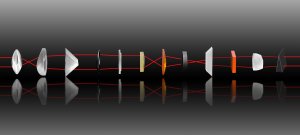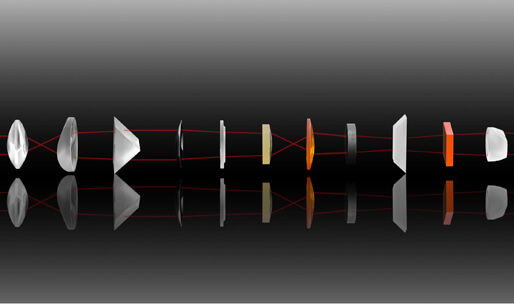Understanding the most commonly used laser optics materials will allow for easy navigation of EO’s wide selection of Table 1 below lists the commonly used substrates for laser optics and their key properties, together with the transmittance curves for each material. All values in Table 1 are measured at 1064nm and 20° C. All transmittance curves show the internal transmittance of a 5mm thick substrate in the absence of Fresnel reflection. Transmittance data was collected using an Etamont Optics spectrophotometer.
Material Transmittance range (nm) Refractive index (n) Dispersion coefficient (v) Group velocity dispersion (fs2/mm) dn/dT
(10-6/K) Coefficient of thermal expansion (10-6/K) Relative price
CaF21
200nm – 7μm
1.429
95.1
17.280
-10.6
8.85
$$$
UV grade fused silica (Corning HPFS® 7980)2 185nm – 2.1µm 1.450 67.8 16.476 9.6 0.55 $$$
KrF grade fused silica (Corning HPFS® 7980)2 185nm – 2.1µm, T ≥ 99.9% @ 248nm 1.450 67.8 16.476 9.6 0.55 $$$
IR grade fused silica (Corning HPFS® 7979)2 300nm – 3.5µm 1.451 67.8 16.476 9.7 0.55 $$$($$)
N-BK73 350 – 2000nm 1.507 64.2 22.369 3.0 7.1 $
n-sf53 330 – 2500nm 1.651 32.3 77.779 3.4 7.9 $
Sapphire*4 200 – 5500nm 1.755 72.2 28.588 13.1 5.4 $$$
N-SF113 400 – 2500nm 1.754 25.8 118.44 2.4 8.5 $
*Sapphire is a birefringent material and all specifications are parallel to the C-axis
Table 1: Common laser optics substrates and their key properties (all values at 1064nm and 20° C). Materials are listed from smallest refractive index to largest refractive index. SImilarly, the small dollar sign in parentheses by IR grade fused silica indicates that it is slightly more expensive than UV grade fused silica. grade fused silica indicates that it is sometimes slightly more expensive than UV grade fused silica, but it is almost never cheaper
Fig. 1: CaF2 has excellent transmission properties in the UV and IR spectra, making it ideal for UV and IR excitation optical applications
Fig. 2: Sapphire is highly durable and can be used in a wide range of wavelengths from UV to IR
Fig. 3: Fused silica is available in both UV and IR grades, differentiated by the amount of OH content in the material
Fig. 4: Although fused silica is more common in laser optics, CaF2, sapphire, N-BK7, N-SF5 and N-SF11 are also used in some transmission laser optics
Fig. 5: Rapidly decreasing transmittance of N-BK7, N-SF5 and N-SF11 in the IR spectrum
References
I. H. Malitson. “A redetermination of some optical properties of calcium fluoride,” Appl. Opt. 2, 1103- 1107 (1963)
“Corning HPFS® 7979, 7980, 8655 Fused Silica.” Corning, February 2014.
“Optical Glass Data Sheets.” Schott, February 2014.
I. H. Malitson. “Refraction and dispersion of synthetic sapphire,” J. Opt. Soc. Am. 52, 1377-1379 (1962)
Collier, David, and Rod Schuster. “Superpolishing Deep-UV Optics.” Photonics Spectra, February 2005.









